(Author’s note; The following post is a republished article of mine, originally published on June 12, 2014 by The Conversation and later republished by The New Republic, The Guardian, Quartz, and several other online news sources. However, this post is an embellished version, in which I include a paragraph on dinosaur microbiomes omitted from the original, and it uses my personal photographs and captions to illustrate its points about dinosaur paleoecology. So you might say this is the “director’s cut.” Many thanks to The Conversation editor Nick Lehr for helping turning my rough prose for the original article into one more readable for a general audience.)
Like many moviegoers this summer, I plan to watch Jurassic World. And because I’m a paleontologist, I’ll cheer for the movie’s protagonists (the dinosaurs) and jeer at the villains (the humans). But no matter how thrilling this movie may be, one question will plague me throughout: where are the dung beetles?
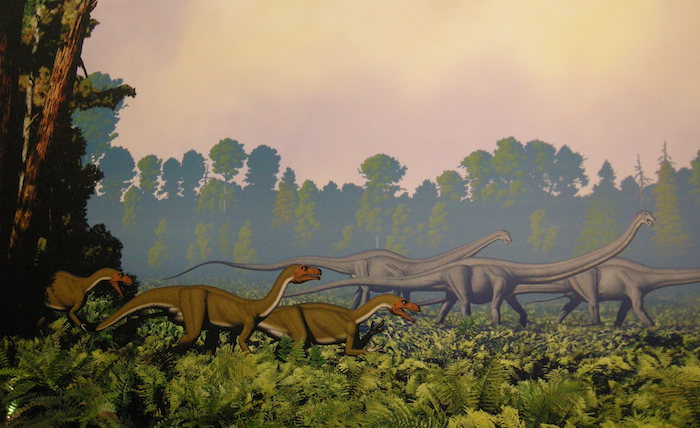 This mural depicts theropod dinosaurs (foreground) and sauropod dinosaurs (background) as part of a Late Jurassic ecosystem about 150 million years ago. OK, so this ecosystem has some producers (plants), primary consumers (herbivores, the sauropods), and secondary consumers (carnivores, the theropods). What’s missing from this picture that would be needed to make this a real, functioning ecosystem? If you said “Dung!” and “Dung beetles!,” you’re on the right track. (Mural by Robert F. Walters and Tess Kissinger (Walters & Kissinger) at the Carnegie Museum of Natural History, photograph by Anthony Martin.)
This mural depicts theropod dinosaurs (foreground) and sauropod dinosaurs (background) as part of a Late Jurassic ecosystem about 150 million years ago. OK, so this ecosystem has some producers (plants), primary consumers (herbivores, the sauropods), and secondary consumers (carnivores, the theropods). What’s missing from this picture that would be needed to make this a real, functioning ecosystem? If you said “Dung!” and “Dung beetles!,” you’re on the right track. (Mural by Robert F. Walters and Tess Kissinger (Walters & Kissinger) at the Carnegie Museum of Natural History, photograph by Anthony Martin.)
Dung beetles – which are beetles that eat and breed in dung – would be only one of many ecological necessities for an actual Jurassic World-style theme park. Yes, cloning long-extinct dinosaurs is impossible. But even if dinosaur genomes were available, the animals couldn’t simply be plopped anywhere.
So for the sake of argument, let’s say an extremely wealthy corporation did manage to create a diverse bunch of dinosaurs in a laboratory. The next step in building a Mesozoic version of Busch Gardens would be figuring out how to recreate – and maintain – the dinosaurs’ ecosystems. Accomplishing this goal would require a huge team of scientists, consisting (at minimum) of paleontologists, geologists, ecologists, botanists, zoologists, soil scientists, biochemists and microbiologists.
Such a team then would have to take into account countless interacting factors for the dinosaurs’ recreated habitats. And perhaps they could take a page from rewilding efforts that are currently taking place throughout the world.
In a memorable scene from the original Jurassic Park, paleobotanist Dr. Ellie Sattler examines an impressive heap of an ill Triceratops’s feces to look for digested remains of a toxic plant.
One of my favorite scenes in Jurassic Park (1993), when Dr. Ellie Sattler (played by Laura Dern) affirms her Ph.D. (= “Piled Higher and Deeper”) by unhesitatingly plunging her hands into a massive pile of Triceratops feces. Please note her sensible footwear, suitable for running away from theropods planning to add her to the local food web.
Here, the filmmakers touched on a key challenge for recreating an environment from a different geologic period. Many modern plants have evolved defenses against herbivores, which include toxins that can swiftly impair any animal that hasn’t adapted to them. Consequently, a time-traveling Triceratops would be taking a big risk with every visit to its local salad bar.
Paleobotanists could try to solve this problem by cataloging fossil plants that lived at the same time as plant-eating dinosaurs, before picking out descendants of those plants that are still around today. Still, plant lists will never be good enough to say whether or not a Triceratops, Stegosaurus, or Brachiosaurus ate those plants or if they could eat their descendants.
The same might hold true for carnivorous dinosaurs, which – for all we know – may have been picky eaters. For instance, although some Triceratops bones hold tooth traces of Tyrannosaurus, there’s no way to be sure a genetically engineered Tyrannosaurus would eat an equally inauthentic Triceratops (even if it were organic and free-range).
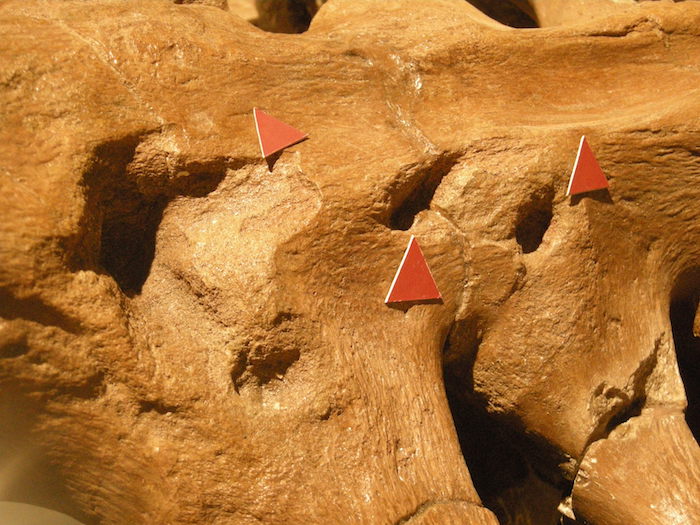 Did tyrannosaurs ever eat Triceratops? Oh yeah, and with gusto. Tooth trace fossils in Triceratops hip bones (red arrows) happen to match the dental records of Tyrannosaurus rex, which lived as the same time (Late Cretaceous, 65-70 million years ago) and place (western North America) as Triceratops. Also think about how much meat was covering that hip bone, which means the Triceratops must have been dead when this tyrannosaur was helping to recycle its body into the ecosystem. (Specimen in Museum of the Rockies and photograph by Anthony Martin.)
Did tyrannosaurs ever eat Triceratops? Oh yeah, and with gusto. Tooth trace fossils in Triceratops hip bones (red arrows) happen to match the dental records of Tyrannosaurus rex, which lived as the same time (Late Cretaceous, 65-70 million years ago) and place (western North America) as Triceratops. Also think about how much meat was covering that hip bone, which means the Triceratops must have been dead when this tyrannosaur was helping to recycle its body into the ecosystem. (Specimen in Museum of the Rockies and photograph by Anthony Martin.)
Yet another food-related dilemma is that we also are not quite sure how most dinosaurs digested what they ate. For instance, many modern animals – from termites to humans – require a suite of gut bacteria to break down and assimilate nutrients from food. Even if microbiologists somehow successfully recreated the microbiome of a dinosaur, how would you prevent it from acquiring modern gut parasites? Dinosaur coprolites (fossil feces) tell us that some dinosaurs had gut bacteria and parasites: but how to engineer the right bacteria and exclude the wrong parasites?
So despite a century of dinosaur flicks portraying tyrannosaurs and other predatory dinosaurs gratuitously munching humans, one bite of our species – or other sizable mammals – might make them sick. In other words, there’s no accounting for taste.
The lack of dung beetles in that same scene with Dr. Sattler also may have explained why the Triceratops’s feces were piled so high. We know from fossil burrows in dinosaur coprolites that dung beetles fed on dinosaur droppings at least 75 million years ago. Similarly, Late Jurassic dinosaur bones from nearly 150 million years ago hold the traces of carcass-eating insects.
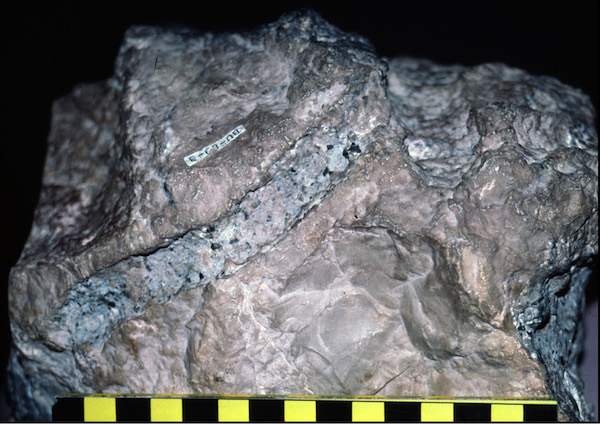 A large, 75-million-year-old coprolite – attributed to the hadrosaur Maiasaura – filled with digested plant debris, but also with dung-beetle burrows. One burrow is sliced length-wise and runs diagonally (upper right to lower left), and another is in cross section and pointed toward you (upper right). Specimen is from the Museum of the Rockies but was part of a traveling display at Fernbank Museum of Natural History in the late 1990s. (Photograph by Anthony Martin.)
A large, 75-million-year-old coprolite – attributed to the hadrosaur Maiasaura – filled with digested plant debris, but also with dung-beetle burrows. One burrow is sliced length-wise and runs diagonally (upper right to lower left), and another is in cross section and pointed toward you (upper right). Specimen is from the Museum of the Rockies but was part of a traveling display at Fernbank Museum of Natural History in the late 1990s. (Photograph by Anthony Martin.)
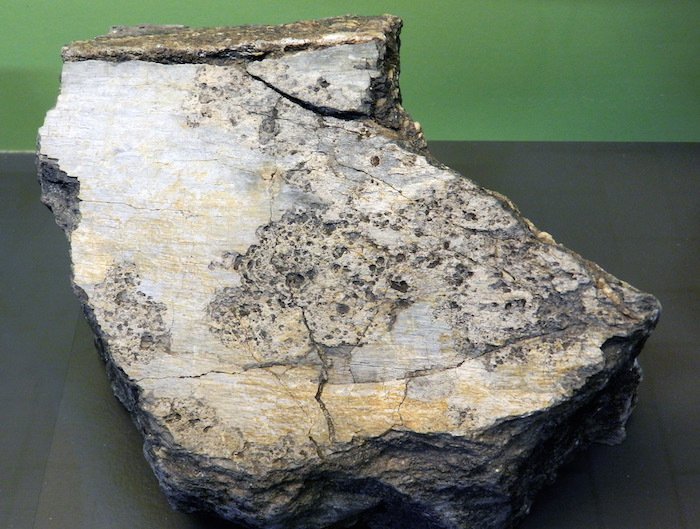 Late Jurassic (about 150 million-year-old) dinosaur bone with insect borings, which are credited to carcass- and bone-eating insects that used these bones for food or breeding soon after the dinosaur was dead. Specimen on display at Dinosaur National Monument near Vernal, Utah. (Photograph by Anthony Martin.)
Late Jurassic (about 150 million-year-old) dinosaur bone with insect borings, which are credited to carcass- and bone-eating insects that used these bones for food or breeding soon after the dinosaur was dead. Specimen on display at Dinosaur National Monument near Vernal, Utah. (Photograph by Anthony Martin.)
This makes sense: wastes, bodies and other forms of stored matter and energy must be recycled in functioning modern ecosystems. Accordingly, to maintain the productivity of these dinosaurs’ ecosystems, animals that perform essential services to the ecosystem would need to be introduced. These include pollinators, such as bees, beetles and butterflies, as well as seed dispersers, like birds and small tree- and ground-dwelling mammals. Thus Masrani Global – the imaginary corporation tasked with creating Jurassic World – should have added entomologists (insect scientists), ornithologists and mammalogists to the career opportunities page on its mock website.
Can we learn anything useful from such fanciful reconstructing of long-gone ecosystems, where large animals once roamed? Sure. In so-called “rewilding” projects, imagination meets real science. These projects, which attempt to restore ecosystems by closely mimicking their previous iterations, often include reintroducing locally extinct animals.
Perhaps the most famous and successful of such rewilding projects began just after the release of the original Jurassic Park. In 1995, wolves were reintroduced to Yellowstone National Park. Although admittedly not as exciting as releasing a pack of velociraptors into the woods, the reintroduction of wolves – which had been extirpated from the area earlier in the 20th century – had a dramatic restorative effect.
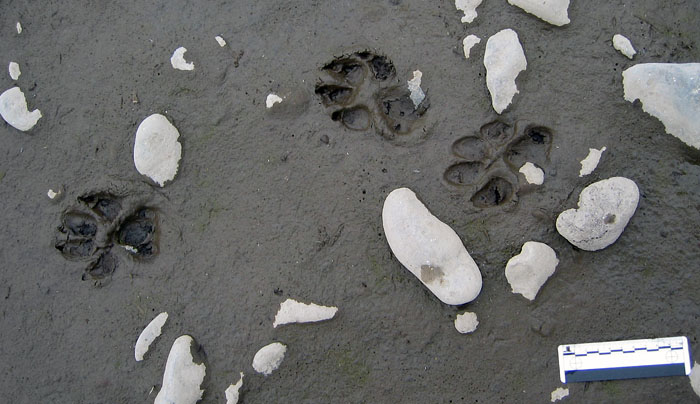 If you looked for these tracks in Yellowstone National Park before the original Jurassic Park came out in 1993, you would have been disappointed. They’re from gray wolves (Canis lupus) and are signs of a now-thriving population of these apex predators reintroduced to the Greater Yellowstone Ecosystem in 1995, which has since caused big changes there. (Photograph by Anthony Martin.)
If you looked for these tracks in Yellowstone National Park before the original Jurassic Park came out in 1993, you would have been disappointed. They’re from gray wolves (Canis lupus) and are signs of a now-thriving population of these apex predators reintroduced to the Greater Yellowstone Ecosystem in 1995, which has since caused big changes there. (Photograph by Anthony Martin.)
After the wolves gorged on elk – which, without predators, had overpopulated the region – riverine foliage grew more lushly. This prevented erosion and expanded floodplains, which gave beavers a better habitat to get to work damming rivers. A similar experiment is taking place in Europe, where increased numbers of large carnivores, such as wolves, bears and lynxes, are reshaping their ecosystems closer to their original states.
Bolstered by these successes, rewilding proponents have even proposed reintroducing elephants, lions, cheetahs and other animals to parts of North America as ecological proxies to mammoths, American lions and American “cheetahs” that lived only a little more than 10,000 years ago in those areas. Given the much shorter elapsed time since their extinction, enough similar species today and no need for genetic engineering, a “Pleistocene Park” – Pleistocene being the geological epoch that was about 2.5 million to 11,700 years ago – would be far easier to achieve than a Jurassic World (while also being more alliterative).
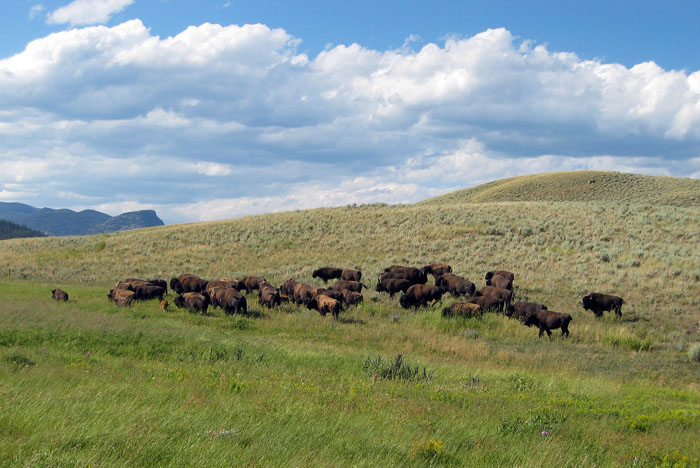 You want a “Pleistocene Park”? Here’s a start, with herds of large primary consumers (Bison bison, otherwise known as “bison”) and grasslands in Yellowstone National Park, which overlap in range with secondary consumers wolves and grizzly bears. Now just add some elephants, lions, cheetahs, and a bunch more dung beetles, and you should be set. Wait a minute: you say the National Park Service wouldn’t approve of that? Oh well, one step at a time. (Photograph by Anthony Martin.)
You want a “Pleistocene Park”? Here’s a start, with herds of large primary consumers (Bison bison, otherwise known as “bison”) and grasslands in Yellowstone National Park, which overlap in range with secondary consumers wolves and grizzly bears. Now just add some elephants, lions, cheetahs, and a bunch more dung beetles, and you should be set. Wait a minute: you say the National Park Service wouldn’t approve of that? Oh well, one step at a time. (Photograph by Anthony Martin.)
So to any corporations out there that are thinking of making such a park, do us a big favor: whatever you do, don’t forget to include dung beetles.
